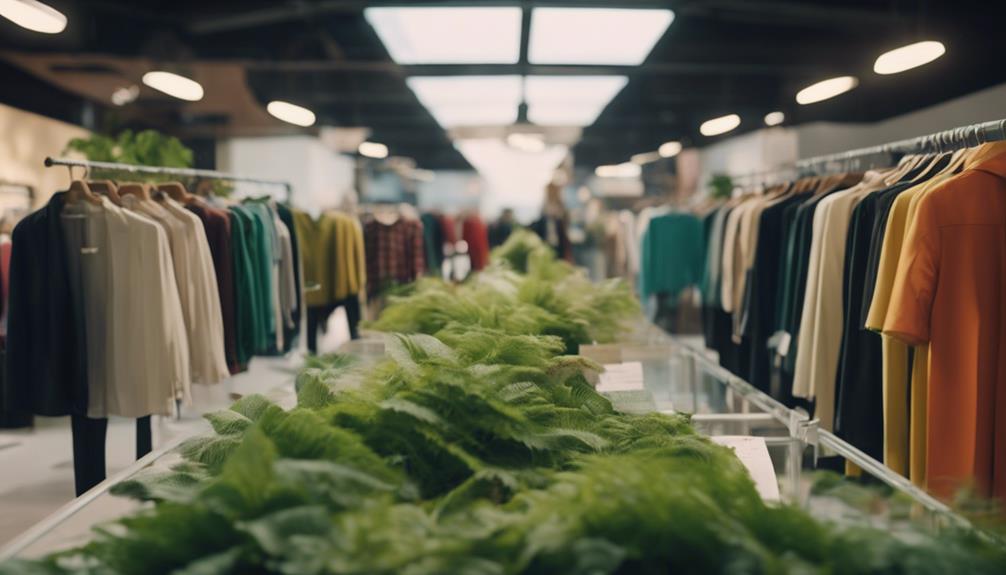Sustainable fashion is indeed facing a pricing dilemma, but the solution may surprise you! Higher production costs resulting from eco-friendly materials and ethical labor practices often lead to higher prices. However, there is a growing consumer demand for affordable sustainable options. Innovative business models, such as rental services and resale markets, are emerging, making eco-friendly choices more accessible. With advances in technology and a shift towards a circular economy, brands are finding ways to reduce costs while maintaining quality. Additionally, government incentives can help lower prices. Stay tuned to learn more about how sustainable fashion is evolving!
Key Takeaways
- Sustainable fashion can lower production costs through circular economy principles, minimizing waste and enhancing efficiency.
- Innovative business models like rental and resale services make sustainable options more affordable for consumers.
- Government incentives and regulatory frameworks can help reduce prices while promoting ethical consumption and transparency.
- Investing in durable sustainable materials leads to long-term savings, offsetting initial higher production costs.
Understanding Pricing Challenges
When it comes to sustainable fashion, understanding the pricing challenges is vital for both brands and consumers traversing this complex market. Sustainable brands often face higher production costs due to eco-friendly materials and ethical labor practices. This results in price premiums that can deter price-sensitive consumers, who are often drawn to more affordable fashion options. The competitive landscape complicates matters further, as rivals can undercut prices, influencing consumer perception of value and making it difficult for sustainable brands to maintain market share.
Despite a significant percentage of global consumers expressing willingness to pay more for sustainable products, price sensitivity remains a formidable barrier. Economic downturns can exacerbate this issue, leading consumers to prioritize affordability over sustainability.
Additionally, the lack of clear definitions surrounding 'sustainable fashion' creates confusion. As consumers demand transparency about what contributes to garment costs, brands must communicate effectively to bridge the gap. By addressing these pricing challenges, sustainable fashion can work towards overcoming consumer skepticism and encouraging broader adoption.
Understanding these dynamics is vital for both consumers and brands as they navigate the complexities of the sustainable fashion market.
Consumer Behavior Insights

Consumer attitudes toward sustainable fashion reveal a complex interplay between the desire for eco-friendly products and the harsh reality of price sensitivity. While 66% of global consumers say they're willing to pay more for sustainable brands, a staggering 96% of UK consumers prioritize affordability over sustainability. This contradiction highlights how price points considerably influence purchasing decisions.
As consumer awareness rises, many individuals are becoming more conscious of the environmental impacts of fast fashion. For instance, 43% of US consumers have actively avoided these brands for sustainability reasons, and 25% are increasing their eco-conscious purchases. Millennials and Gen Z, who make up a massive 69% of online sustainable product purchases, are leading this shift, with 71% of UK Gen Z females considering sustainability essential when shopping.
However, skepticism looms large, as 88% of consumers doubt sustainability claims, emphasizing the need for transparent, authentic communication from brands.
Notably, the resale clothing market's rapid growth suggests a willingness to embrace more affordable sustainable options, with 83% of Gen Z open to buying second-hand. This shift indicates a potential path toward sustainable fashion's evolution amid pricing challenges.
Innovative Solutions in the Industry

Innovative solutions are emerging in the fashion industry, addressing the pricing challenges of sustainable options while appealing to eco-conscious consumers.
The adoption of circular economy principles considerably lowers production costs and minimizes waste, making sustainable fashion more accessible to you. Technological advancements, like automated manufacturing processes and digital fabric printing, enhance efficiency and reduce costs in creating sustainable garments.
Collaborative initiatives among brands, such as shared resources and co-development projects, also lead to reduced expenses, making sustainable fashion options more affordable. While investing in sustainable materials might seem costly initially, it can yield long-term savings due to increased durability and a reduced need for frequent replacements. This ultimately lowers costs for you as a consumer.
Moreover, innovative business models like rental and resale services diversify revenue streams and provide you with more affordable access to sustainable fashion choices. As these solutions continue to evolve, the fashion industry can bridge the pricing gap, encouraging more individuals to embrace sustainable practices without compromising their budgets.
Regulatory Influences on Pricing

Government policies increasingly shape pricing strategies in the sustainable fashion sector, encouraging brands to adopt eco-friendly practices that can lower costs for you over time. As regulatory frameworks evolve, they're fostering an environment that promotes ethical consumption and transparency.
Here are some ways these regulations influence pricing:
- Incentives for Sustainable Practices: Governments may offer tax benefits or subsidies to brands that prioritize eco-friendly production, which can lead to lower prices for you.
- Consumer Protection Laws: Stricter laws compel brands to be transparent about their pricing and sustainability claims, reducing instances of greenwashing and building your trust in their products.
The Future of Sustainable Fashion

The future of sustainable fashion looks bright, with a surge in demand for eco-friendly products driving brands to adopt more responsible practices.
As consumer demand for sustainable fashion continues to grow, you'll notice a shift toward higher prices reflecting the true cost of ethical production. This shift isn't just about spending more; it's about valuing transparency and accountability in the fashion industry. In fact, 67% of consumers now consider sustainable materials essential when making purchasing decisions.
Moreover, the sustainable fashion sector is projected to reach an impressive market value of $10 billion by 2025 and $33.05 billion by 2030. This growth indicates that consumers are increasingly willing to invest in eco-friendly options. Innovations in sustainable materials, like plant-derived and recycled fabrics, are flourishing, with 102 companies dedicated to developing these next-generation textiles.
Additionally, the resale clothing market is booming, expected to hit $350 billion by 2027. This trend highlights a behavioral shift towards second-hand and circular fashion options, further fueling the sustainable movement.
Fundamentally, the future of sustainable fashion isn't just promising; it's transformative.
Frequently Asked Questions
What Problem Does Sustainable Fashion Solve?
Sustainable fashion solves environmental issues by reducing carbon emissions and pollution. It promotes fair labor practices, encourages responsible consumption, and supports the circular economy, ultimately creating a more ethical and eco-friendly industry for you to engage with.
Why Isn't Sustainable Fashion More Affordable?
Sustainable fashion's pricing feels like a luxury car's sticker shock—you want it, but the cost makes you hesitate. Higher production costs and ethical practices lead to prices that can deter even the most eco-conscious consumers.
Why Is Sustainable Fashion Unaffordable?
Sustainable fashion's often unaffordable because it relies on eco-friendly materials and ethical labor, leading to higher costs. Many consumers prioritize price over sustainability, making affordable options scarce, especially during economic downturns when spending decreases.
Is Sustainable Clothing More Expensive?
Yes, sustainable clothing is generally more expensive due to higher production costs, ethical labor practices, and eco-friendly materials. However, investing in quality can save you money long-term by reducing the need for frequent replacements.
Is the Pricing Problem in Sustainable Fashion Preventing Its Existence?
The pricing problem in sustainable fashion is hindering its existence. Despite sustainable fashion’s astonishing truth, the high cost of eco-friendly materials and ethical labor practices often result in higher prices for consumers. This creates a barrier for many people to support and invest in sustainable fashion, ultimately limiting its growth and impact.
Conclusion
To summarize, sustainable fashion isn't just about eco-friendly materials; it's also about making ethical choices accessible to everyone.
By addressing pricing challenges through innovative solutions and understanding consumer behavior, the industry can thrive.
So, can we really justify paying more for sustainability when the planet's future hangs in the balance?
As consumers, it's time to demand change and support brands that prioritize both our wallets and the environment.
Together, we can shape a more sustainable future.









